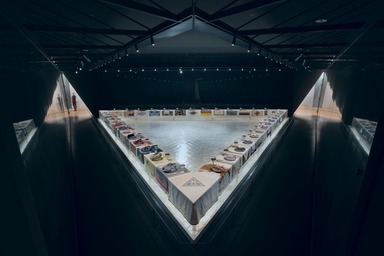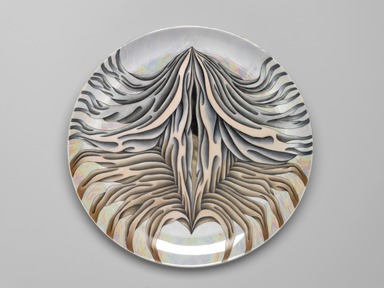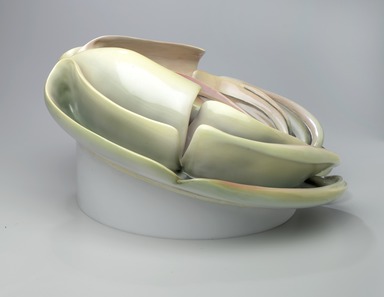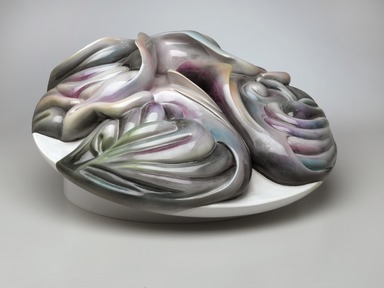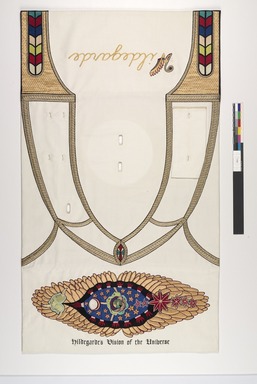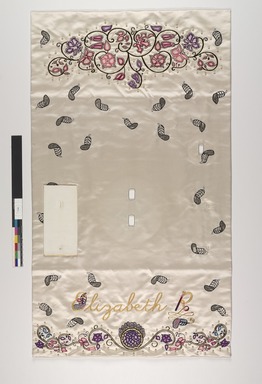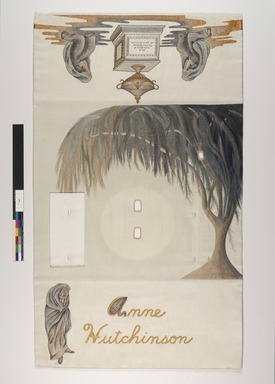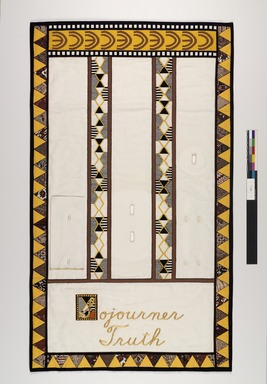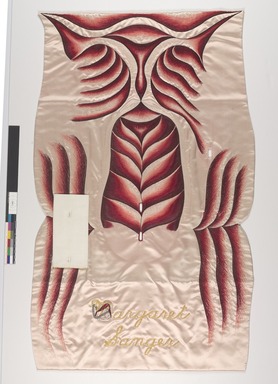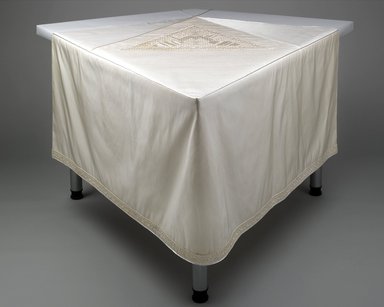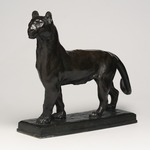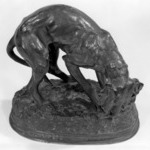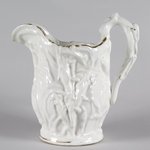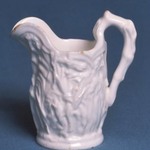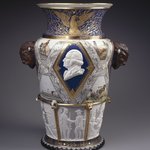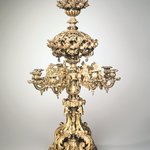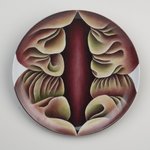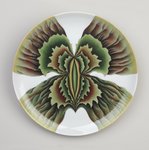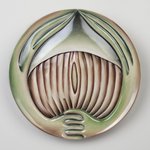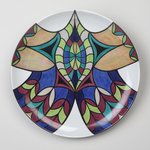It seems like most of these women are already pretty well known and already part of the historical record. Can you clarify how a celebration of these women "pays tribute to all women who have been lost to history"?
That is a good point. Although we thankfully now know much about these women now, the same couldn't be said in the 1970s, when the piece was created. Most of these women were unknown, or their biographies and contributions were lesser known. The process for discovering these women and their contributions required years of intensive research to flesh out their biographies.
Judy Chicago wanted to restore women to the historical narrative, and she employed a team of research assistants to help her learn more about these women's lives in the pre-digital and pre-internet world. But it is a good point that now some of the women at the Dinner Party are known. It doesn't mean the work is over, however! I think the work also encourages us to move beyond this list and continue to include more women who are overlooked by history. The 999 women's names on the Heritage Floor are intended to signify that there are multitudes of women who have yet to be acknowledged.
Has Judy Chicago ever considered ending her discrimination against transgender women and women of color via their inclusion at The Dinner Party?
As a physical installation, The Dinner Party is a static piece, changes have never been made to it. Judy Chicago has said that the biographies she found for inclusion here were limited by language barriers and fragmented histories. Her intention was not to give us a definitive women's history but to begin the process of putting women back into the narrative.
Also, it’s important to remember that this work was completed in 1979, well before more nuanced conversations about topics like intersecting identities and transgender visibility took place.
But you bring up an important conversation that should be happening, and thankfully the Sackler Center's special exhibitions continually try to fill that gap and engage in contemporary discussions about gender and identity. The curators strive for a wider definition of feminist art and also regularly bring living artists into conversation with the Dinner Party as a way to bring LBGTQI artists to the table (pun intended).
Was "The Dinner Party" intended for this exact room?
No, this room was actually built for The Dinner Party. Elizabeth Sackler purchased it for the Brooklyn Museum under the provision that we would build a feminist art gallery for it. The Museum and Judy Chicago worked with designers to ensure that the piece would be able to stay on view long-term with minimal wear. Many considerations have gone into the installation to protect the work, such as the low lighting and the mirrored walls that help to reflect and maximize it.
That's interesting. Has it ever been moved?
Since its installation, no. But when Judy Chicago first created the work it travelled the world for 9 years, visiting 16 venues in 6 countries on 3 continents, reaching a viewing audience of 15 million. Thankfully it has found its permanent home here and can finally rest a bit.
At "The Dinner Party," where does the text on the entry banners come from?
The words come from the artist herself, Judy Chicago. The text speaks of Chicago’s hope for a more equal world, one in which women’s history and perspectives are fully recognized and integrated into all aspects of human civilization. The banners were woven at the San Francisco Tapestry Workshop and they echo some of the visual motifs of the larger overall installation.
Are these place settings presented in chronological order?

Yes! It begins at the corner with the ancient goddesses and runs chronologically to the 20th century. Chicago describes the breakdown of each of the three wings like this: First, prehistory and ancient goddess worship through Classical Rome ending in the early days of Christianity. Next, the rise of widespread Christianity and the last days of Rome through to the Reformation. Last, the Enlightenment into the twentieth century with an emphasis on the early seeds of the feminist movement. The increase in dimensionality of the plates is a reference to women’s visibility and level of participation in society over time.
The lighting in "The Dinner Party" makes the setting feel almost spiritual.
I see what you mean! The lighting seems dramatic and also helps to conserve the work while it is on long-term view. These special lights don't emit any UV rays that could damage the many different materials of the installation
like textiles.
What is the significance of the art on the cloths under the plates?
Just like the plates, the fabric runners at each place setting are designed to specifically represent each woman's achievements and/or culture. The runners use visual symbolism and are executed in textile techniques common to the woman's time and place. Each runner also features the woman's name with the first letter "illuminated," meaning decorated, with some specific symbols.
What is the floor made of?
This monumental floor is comprised of 2,304 hand-cast porcelain tiles and provides both a structural and metaphorical support for The Dinner Party table. Inscribed in gold luster are the names of 999 mythical and historical women of achievement, who were selected to contextualize the 39 women represented in the place settings.
What are the goblets made of?
The chalices and flatware are all made of porcelain with an iridescent glaze.
Is this all hand done?

Yes, the plates were hand cast in molds and painted by hand. The runners are all hand embroidered as well. Chicago wanted to draw attention to the artistry of techniques deemed craft.
Where was "The Dinner Party" first?
The first exhibition of The Dinner Party was at the San Francisco Museum of Modern Art in 1979. It continued on a decade long tour from there including a special exhibition at the Brooklyn Museum in 1980-81!
Is it fair to say that the piece was made in a time when feminism centered on white women? Also that she essentialized a lot of non-western/non-white women by using stereotypical "tribal" patterns? Could she have done more to center women of color in the piece?
The Dinner Party was created in the late 1970s, and was very much tied into white, mainstream second wave feminism of the time.
Chicago has stated that, “our choices were limited by language barriers, fragmented information, and our own inexperience and biases. Our intention, however, was not to define women's history but to symbolize it – to say that there have been many women who have done many things, and they deserve to be known.”
Her own perspective on the subject and biases absolutely led to some of the decisions and motifs that were used in work.
Why was a dinner party chosen as the format?
The idea appealed to the artist on many levels because the dinner table itself carried symbolic meaning for women historically, the place where meals were served in the domestic “feminine” space. It is also connected to historical imagery like the Biblical Last Supper. Chicago describes this installation as “a reinterpretation of the Last Supper from the point of view of those who’ve done the cooking throughout history.”
For Chicago, from the start, her aim was “to teach a society unversed in women’s history something of the reality of our rich heritage." At first, she conceived of it as a series of twenty-five china-painted plates to hang on a wall, titled Twenty-five Women Who Were Eaten Alive, a reference to the ways in which women had historically been “swallowed up and obscured by history instead of being recognized and honored.”
While planning the project, she visited the home of a professional china-painter who had spent several years producing an elaborate dinner service for 16 people. The settings were arranged in order on the painter’s dining room table. Chicago claims she had an epiphany at that moment, “realizing that plates are meant to be presented on a table.”
Does this have any relation to Caryl Churchill's play "Top Girls"?

"Top Girls" was written in 1982, just a few years after "The Dinner Party" was completed in 1974-79. It seems, Churchill did take some inspiration from the set-up of Judy Chicago's installation. The two works certainly come from the same, second wave feminist movement.
Thanks.
I have done some reading on "The Dinner Party" and one of the criticisms is that it upholds the traditional "white feminist narrative" because there is only one black woman represented at the actual table. How does the museum respond to this?
You're absolutely right. If The Dinner Party was made today it would certainly come out very differently. Chicago acknowledges herself that this is a "limiting" view of women's history and that it is limited to the West.
We look at The Dinner Party as a small step, but still a step in the right direction. We must also remember that this was made in the 1970s and was advanced at that time, if not by our modern standards. And the gallery spaces surrounding the installation are used for exhibitions that help expand and update the narrative of Chicago's work.
Did Judy Chicago collaborate with other artists for The Dinner Party or do all of it herself?
For the first year and a half of the work on The Dinner Party, Judy Chicago worked alone. After that, she collaborated with a host of other artists, administrators, and volunteers. Chicago conceived of designed the enormous work and made a point to learn all of the techniques represented, like embroidery and ceramics. Doing it all herself would have taken much more than five years though! In all, 400 total volunteers contributed to the project in some way. The bulk of the work was done by 23 people who worked alongside Chicago continuously.
Was "The Dinner Party" by Judy Chicago a statement about women in a domestic household role, or a woman's role in the arts?

Chicago's emphasis on ceramic and textile arts was certainly a deliberate choice to celebrate women by using the media that they were typically limited to. She also designed the plate of Virginia Woolf and Georgia O'Keeffe as the most sculptural because these two women developed and used new female literary and visual language to describe their own experiences. The overall concept of this installation as a dinner party stems from Last Supper imagery and a commentary on women's historic "place," in the home, cooking.
Thank you.
Do the place settings represent real people?
Some do and some don't. The majority of the women included were real people. There are several goddesses and legendary women represented as well, like Kali and Ishtar. There is one setting, Trotula, who was, in the 1970s, believed to be a historical women. However, in the 1990s scholars deduced that Trotula is not the name of a woman, but just the name of a collection of texts!
I wondered about the way that the Black Radical Women show surrounds Judy Chicago's The Dinner Party. Was any thought given to addressing the critiques of Chicago's work or staging a more direct confrontation between the show and Chicago's work?
I think the two shows are definitely in conversation with each other although the placement of the two exhibitions wasn't necessarily deliberate since The Dinner Party is a permanent installation. Likewise the staging of the Black Radical Women show is, in part, related to the proximity to the Elizabeth A. Sackler Center for Feminist Art.
Right, and in many ways the black radical women show hopefully offers a new critical lens through which to view Chicago's work.
I'm interested to hear your thoughts on the proximity to the two exhibitions. They certainly inform one another. As you may have gleaned from the wall texts, many of the collectives of black women artists that were formed were reacting against the alienation the felt from the mainstream feminist movement of the time, of which Chicago was certainly a part (white, female, middle-class).
So the two shows so close to one another definitely highlight the relative lack of color and non-western perspectives in Chicago's work. I think its also interesting to see how, like the installation of the two shows suggest, these two movements were happening simultaneously but in a way, almost had nothing to do with each other.
Yes, exactly and it's interesting to consider Chicago as a central permanent work in the Brooklyn Museum's collection and the way that collecting/institutionalizing of radical works of art plays out across categories of race.
That is a good point. However, many of the works that are in the We Wanted a Revolution show are a part of our permanent collection and some of the artists in the show appear elsewhere in the museum.
Oh yes, BKM has been far better than most institutions.
But institutional support, or lack thereof at the time when many of these black radical women were creating their work, is definitely a theme of the show. In fact, its what necessitated the collectives in the first place; they provided a network of support that wasn't available for them through more traditional means in the art world. So, taken together (Black Radical Women and Chicago), it is certainly another disparity that is being addressed, although somewhat unintentionally. But importantly, nonetheless!!
Absolutely! Build your institutions and determine your own cultural worth!
Yes, it's what impresses me about the artists in this show. That they refused to let their lack of access stop them from creating their work. They carved out spaces for themselves and for each other and demanded that their voices be heard.
Is there any significance to the plates? They kind of seem like vaginas.
Some of them are. The Dinner Party makes use of forms that are associated with femininity, fertility, and transformation, including vulvas, butterflies, triangular shapes, and floral shapes. Chicago coined the term “central core” to describe this imagery built around the vulvar shape. Her intention was to reclaim the form of the female genitalia and cast it in a positive light. This, however, has also been one of the chief critiques of The Dinner Party: that is essentializes women down to their genitalia, and that it upholds the gender binary.
I'm Mexican so this is an obvious question: do you have any idea why Juana Ines de la Cruz was not included in "The Dinner Party"?
Judy Chicago considered including Sor Juana Ines de la Cruz, but ultimately settled on Anna von Schurman who had a somewhat similar story. It wasn't until after the project was completed that Chicago learned more about Sor Juana and actually regrets not giving her her own place.
Thanks Rachel. Though centered on women, the piece is very western European in focus. It presents a very traditional view of history.
Chicago herself has acknowledged that discrepancy. The piece is very much a product of its time and, more so, of Chicago's worldview at the time so there are definitely some areas of the world and some women who were overlooked during its conception. I think the Elizabeth A. Sackler Center for Feminist Art does a good job of trying to promote a more inclusive and intersectional view of feminism that broadens the narrative presented in the Dinner Party.
What are the names written on the floor of The Dinner Party?
The floor is called the Heritage Floor and the names of 999 mythical and historical women of achievement are inscribed on it. The names are correlate to the 39 women at the table; visually, they flow out, in streams, emanating from the corresponding woman’s place. These 999 names are there to not only acknowledge these particular women, but also to represent the vast numbers of women who may have been forgotten.
What is symbolism of the triangle? Delta? Change?
I really like your connection! According to Chicago, it has to do with an ancient symbol of the feminine and fertility likely stemming from a pubic triangle. The equilateral triangle is also meant to relate to equality, plus, a triangular table has no head, no one guest is elevated above the others. There are other symbols in The Dinner Party that speak to the idea of transformation and metamorphosis, like the butterfly forms in some of the plates, so you may be right!
How do you keep The Dinner Party clean? Is there a ventilation system that vacuums dust?
The gallery space was designed with The Dinner Party in mind, which contributes to its preservation. Teams of conservators monitor the work quite closely and time their twice annual cleanings so that viewers can get the most out of the work
I'd love to learn more about The Dinner Party.
Created between 1974 and 1979 by Judy Chicago, The Dinner Party was a groundbreaking work of Feminist art and today stands as an iconic symbol of the second wave (or Women's Liberation). She was thinking about the way that women were not equally mentioned or represented in history and art in her own education. Given a literal and figurative place at the table, the guests serve as representatives for the women who's accomplishments have been overlooked by history. Judy Chicago describes it as "a symbolic history of women in Western civilization."
39 women at the table are broken into three sets of 13, the number guests at the Biblical Last Supper. 999 more women on the Heritage Floor signify the multitudes of women still unknown. No two plates or runners are alike. Each one is decorated with images and symbols that tell us about the woman's life and achievements. Many build on an inherently female, vulvar form. The triangular table has no head, equal sides, and recalls an ancient feminine symbol.
I love it so much!
As time goes on the plates become more and more 3D what was the meaning of that?
Very perceptive! The increase in dimensionality of the plates is a reference to women's visibility and level of participation in society. Hatshepsut's plate has an almost imperceptible sculptural quality because she was, after all, the king. The final plates, Georgia O'Keeffe's and Virginia Woolf's, are the most sculptural because Chicago felt it was at this point that women developed their own visual and written language to describe their experiences.
According to Judy Chicago herself: "In the second wing the images rise up and go back down, only to rise up and go back down again. While in the 3rd wing they become progressively more dimensional. This is a metaphor for a women’s desire to become free but is also a metaphor for women’s experience and a symbol of the larger human experience. It is not only women who are not free most people’s lives are limited by their race, their class, or their life circumstances."
OMG amazing! I'm obsessed with that exhibit!
Any suggested reading on The Dinner Party?
Yes! I recommend Chicago's own "From Creation to Preservation" as well as "The Dinner Party and the Power of Popular Feminism" by Jane F. Gerhard.
Is this meant to take place on Passover night?
The thirteen place settings on each side is certainly an allusion to The Last Supper in the New Testament. The Last Supper is said to have taken place a few days before Passover.
Was The Dinner Party initially controversial?
At the time it was completed, 1979, and throughout its history, The Dinner Party has inspired both celebration and criticism. The potentially sexual connotations of the plates caused many people to regard this work as pornographic. It was difficult for Chicago to find places to exhibit the work and even more difficult to find it a permanent home--it finally entered the permanent collection of the Brooklyn Museum in 2002. On the opposite end of the spectrum, it has also been criticized for its limiting view of women's history especially in terms of racial and ethnic diversity. However, the installation was a hit with second wave feminists when it debuted and has gained many more fans in its lifetime. Its tour in the 1980s saw record-breaking attendance; over 1.5 million visited the BKM exhibition alone!
How were the individuals with place settings and the names on the floor selected?
According to Chicago the place settings were selected by the following criteria: 1) Did the woman make a significant contribution to society? 2) Did she attempt to improve conditions for women? 3) Did her life illuminate an aspect of women's experience or provide a model for the future? There are 999 more names on the floor. Each name is part of a grouping that grows from a physically and thematically related place setting. These 999 names are there to not only acknowledge these particular women, but also to represent the vast numbers of women who may have been forgotten.
Thank you very much!
Why did she want us to enter this way?

She intended the entrance to be very stately and processional, as if you are entering a space set aside for contemplation or celebration. Woven into the banners are a series of phrases intended to convey Chicago's vision for "an equalized world, one in which women's history and perspectives are fully recognized and integrated into all aspects of human civilization."
Do you know why she did not personalize the cups and utensils on the table?
On a purely visual level, the sameness of the flatware and chalice is key in uniting all of the very different place settings. Chicago's conceptual reasoning is that despite how different these women were, and despite whatever they accomplished or unique their lives were, they were all essentially treated the same by society. Their accomplishments and contributions were all similarly erased and forgotten.
I really enjoy how the flatware and cups are just slightly larger than human scale. It gives a really goddess-like feeling to these names.You can almost imagine 7-foot tall women seated at the table, and how powerful an image that would be.
Definitely the perfect size for those women! It does give more importance to the plates and settings and also allows for an easier read of the art. Thank you so much for all the info!
What is the silverware of "The Dinner Party" made of?
The "silverware" is actually ceramic! It's made of porcelain, the same material as the plates. All of the chalices and cutlery are covered in the same iridescent and metallic glazes.
Can you tell me more about Judy Chicago?
Judy Chicago, born Judy Cohen, is an artist who began developing her practice during her time at the Art Institute of Chicago and UCLA in the early 1960s. She is best known for works that engage with the feminist movement of the 1960s and 1970s.
"The Dinner Party" by Judy Chicago is the centerpiece of the Elizabeth A. Sackler Center for Feminist Art. The work channels Chicago's interest in how women have been treated throughout history.
Why is everything in the Judy Chicago exhibit larger than it would be in real life?
That's a great observation. I don't know if Chicago ever commented on the scale of the flatware and cups. etc. The flatware does reference the traditionally domestic sphere of women, who would have been the ones to cook and set the table. Perhaps by enlarging the flatware and cups, Chicago is increasing the significance of the role of women.
Chicago has said that each of the place settings is the same because no matter how much each of these women achieved, no matter how different she was, she was treated the same way. This is represented by the sameness of the flatware, the chalice and the napkin.
Perhaps it makes us imagine participants in "The Dinner Party" larger than life, god-like.
I like that interpretation a lot! There are gods at the table after all!
And monuments tend not to be life-sized.
That's another good point. This is very much a monument to these historical figures. It is a very unique approach to the commemorative monument. It is also a monument to traditional women's labor such as needlework and china painting.
Was The Dinner Party reassembled in the museum? How
did that work since its so big?
Yes, it was! As you can imagine, all of those ceramic plates had to be carefully packaged before they were moved. The materials that made up The Dinner Party were packaged into a total of 65 crates, shipped, unpacked, and reassembled.
Regarding "The Dinner Party," is the table setting always the same or has it changed throughout the years? Did it ever include chairs?
There were never chairs in The Dinner Party, they would have blocked the runners! The arrangement of the plates has always been the same. It runs roughly chronologically, from pre-historic times to the early 1900s (with Virginia Woolf and Georgia O'Keeffe)!
Each place has a plate and a runner that were designed as a "set," with imagery and motifs that relate to the woman's life and accomplishments. Chicago designed it as a total work of multimedia art; you would see the banners first, enter at a certain point, and then experience the table.
Did Judy Chicago do all of the embroidery on the placemats?
While Judy Chicago did design all of the table runners, volunteers contributed to the needlework process.
Caroline Herschel's place setting, for instance, was executed by Marjorie Biggs, the most talented embroiderer who worked on the project.
The embroidery is stunningly exquisite. It reminds me of ecclesiastical embroidery, which my mother was an expert in.
Some of the embroidery should absolutely remind you of ecclesiastical embroidery. Chicago was directly influenced by the iconography of medieval Christianity when planning the Dinner Party, and many of the runners use period-appropriate needlework techniques. Chicago actually learned every technique involved in creating the work.
Do you know how Chicago funded the piece? Were all the craftspeople volunteers?
She basically paid for it herself. That said, she did raise funds specifically for the project through activities like lectures series. The lectures were also away to recruit more volunteers. And yes, apart from a core team, the majority of the craftspeople involved were volunteers!
She must have been rich!
Not exactly: Chicago did take on some debt to make it happen. And during the course of the project, the exhibitions, lectures, and art sales that would have supported her were all funneled into making "The Dinner Party". She even sold sketches and test plates, which explains how these preparatory pieces ended up in so many different places!
Thanks for all the info!
Why doesn’t Judy Chicago have a seat at the table?
Judy Chicago wanted to honor other prominent women in history, rather than highlight her own accomplishments. As a nod to artists and the future accomplishments of women, she included a 20th century artist she found inspirational as the last plate at the table, Georgia O'Keeffe.
Is there a religious undertone to Chicago's work?
Chicago did make a tongue-in-cheek comparison to Leonardo da Vinci's The Last Supper, by including 13 women on each side of THIS table!
She called The Dinner Party “a reinterpretation of the Last Supper from the point of view of those who’ve done the cooking throughout history."
Oh man, I was right.
And she definitely included women who played roles in various religions, from ancient goddesses to Hildegarde of Bingen, a Benedictine abbess and mystic.
Where did Judy Chicago get her inspiration for The Dinner Party?
She has said that she wanted to reclaim and present the histories of women who were under-represented in her own education as a student and an artist, and she did years of research to gather notes on women from all eras and occupations.
She created The Dinner Party from 1974 to 1979, and she saw it as an important project in terms of reintroducing women into history and making up for all the omissions that currently existed in the way history was taught.
She has called "The Dinner Party" "a tour of Western Civilization from another point of view, a woman's point of view."
How many women of color are featured in The Dinner Party?
There are two women of color at The Dinner Party: Sacajawea and Sojourner Truth. Kali can be seen to represent women of color as a goddess predominantly worshipped in India and Bangladesh.
Today, Hatshepsut could be considered a person of color, as she is Egyptian, but to the average person in 1979, she would not have been.
If The Dinner Party were made today, it would look very different! Chicago herself acknowledges that The Dinner Party is a limiting view of women's history.
Like when viewing any artwork from the past, we must acknowledge that our modern perspective is different from that of the historical artist.
Along with being a wonderful celebration of women and their history it is also a metaphor of how few seats there have been at the table for women of color.
Yes, I think you are absolutely right - it is very symbolic. Even when the work was completed in 1979, there were critics regarding the lack of diversity. Nearby there is an early guestbook that communicates these critiques.
How many seats are at the table?
There are 39 women represented at the table and another 999 names on the Heritage floor.
What is The Dinner Party about?
The Dinner Party is meant to give women a literal and figurative place at the table. It was the first monumental piece of feminist art.
The guests (both historical and mythological women) serve as representatives for the women who's accomplishments have been overlooked by history.
Were the place settings made by the guests?
No, only some of the women represented at the table are artists and only one of them was still alive (Georgia O'Keeffe) when the work was created.
Each plate and runner was designed by Judy Chicago and executed with the help of a vast team of artisans and volunteers. The surrounding exhibition, Roots of The Dinner Party is all about the process of creating the work.
Was The Dinner Party ever exhibited in Louisiana? Or elsewhere in the South?
My wife remembers seeing it or a similar work in the 80’s.
The Dinner Party was indeed on a world tour from 1979 to 1988, it did make two stops in the South: the University of Houston at Clear Lake and the Fox Theater in Atlanta.
Thank you!
Agency? How is agency part of the conversation here?
Agency is part of the conversation for Chicago because she wanted to emphasize the way that the women in the Dinner Party, and women in Western history in general, made a significant historical impact, contrary to prevailing historical narratives. You will notice that as the women at the place settings progress in time, their plates (the central core imagery) lifts off the table more and more. The increased three dimensionality of the plates represents the increased agency these women had over time!
How many Dinner Parties are there?
The one you are visiting today is the only "The Dinner Party." This work did travel the world from 1979 to 1988. During that tour it visited 14 venues (including the Brooklyn Museum) in six countries.
The Dinner Party has been in the permanent collection of the Brooklyn Museum since 2002 and has been on view in this space since 2007.
Thank you very much.
Can you tell me why a chalice has been placed at the right side of the plate? Thanks.

Great question! The Dinner Party follows conventional rules about how to set a table. I assume cups were traditionally placed to the right of plates because a majority of people are right-handed!
Yes, but why is this type of cup similar to a chalice used by a priest in a church?
There is a religious subtext to certain elements of The Dinner Party. Each side of the table seats thirteen individuals, the same number that attended the Last Supper.
There is definitely an overarching theme of Chicago using the splendor of Judeo-Christian art. The gold chalices specifically are a reference to Christian finery. She's using some of the most gilded and honorific approaches in Western art to honor women, instead of men.
Excellent and interesting information.
All of the plates are personalized based on the person they represent right?
Yes, exactly! Each one has motifs that tell us something about that woman's life and achievements.
The women come from many different periods of time and many different occupations, as you'll see!
Are there only women depicted in the plates, no men?
Only women are depicted in The Dinner Party. It's a celebration of the part women have played in history. A few men worked on Judy Chicago's team in the later stages of the project, but most of the participants in the project were female as well.
Okay, thanks.
Is there any important numerology in The Dinner Party?
Triangles do figure prominently in The Dinner Party. The triangles have several meanings, but one of them is related to them having three sides and three being a significant number in many cultures, often related to completeness.
The number thirteen comes up, but it is less tied to numerology and more to the number of guests at the Biblical Last Supper.
Finally, the number of names on the floor, 999, is meant to symbolize the vast multitudes of women who have been forgotten to history. Chicago also references the number as if it is the end of a cycle (because one more would be one thousand) and preparation for a new beginning.
How is Judy Chicago portrayed today? As in, is she deemed to be a revolutionary artist in the feminist world? Has The Dinner Party impacted history?
She is definitely considered a revolutionary feminist artist, having created not just a highly influential feminist installation during the second wave feminist movement but also an environment for feminist thought among the volunteers who worked on the project.
As for how she is portrayed today, her work has been critiqued in light of new waves of feminist thought, but her work is still significant. Chicago is also remembered for her her trailblazing work with the Feminist Art Program at Fresno State College and CalArts!
Any plans to update the women at the table?
The Dinner Party has remained a static work since it's completion in 1979. Chicago has no plans to update it. Though it might have been made quite differently today, The Dinner Party was an important step towards telling a broader narrative about history and art history. The work encourages viewers to challenge the histories we are taught, and it is frequently used as a prompt for considering who would be honored if it were made today.
Are the cups a reference to the last supper?
Yes! The whole thing is actually a response to The Last Supper...
But instead of one long table with a man presiding, it's many women all together throughout history!
Was this ever banned?
This work has faced some challenges of censorship during its life. Originally scheduled for a four-venue museum tour in 1979, the other three institutions cancelled after the work debuted at the SFMoMA. This was partly because of the controversy about the use of vulvar imagery, and partly due to rejection by the art world in general. Then, the feminist artistic community mobilized to put together a new fourteen-venue tour for the work, which included in the Brooklyn Musuem. In the 1990s the work was looking for a permanent home, and it was set to be acquired by a government affiliated university. Congress had to approve the acquisition of the piece, and so the work was presented before them and debated. Their ultimate ruling was that the work was pornographic, and the university wasn't allowed to acquire it. Even as recently as 2018 the work of Judy Chicago has sparked controversy, and some still view it as inappropriately explicit.
Was "The Dinner Party" supposed to be US-centric?
The Dinner Party is not US-centric, but it does take Western Civilization as its main focus. Chicago’s original intention was to rewrite a historical narrative that centered on male heroes (mostly from Europe and North America) by foregrounding their female contemporaries. She was rewriting the history that she had been taught while growing up and studying in the US, and her perspective reflects this.
This continues to be one of the chief critiques of the installation, that while celebrating women, it only celebrates certain women. However, Chicago was reacting to the existing canon at the time, when most scholarship still focused on Western history.
Is Judy Chicago her real name?
It is now! The artist changed her name to Judy Chicago (after her hometown) around the time of her second marriage, instead of taking her new husband's name. This way, she removed the patriarchal aspect of her name, it no longer came from a husband or a father.
Thank you. Very insightful
and helpful.
Puedes decrime mas sobre esta?

Esta obra se llama The Dinner Party (La Fiesta de Cena) por Judy Chicago.
Esta piesa monumental está compuesto por 2.304 azulejos de porcelana colados a mano y proporciona un soporte estructural y metafórico para la mesa The Dinner Party. Inscritos en brillo dorado son los nombres de 999 mujeres míticas e históricas de logro, que fueron seleccionadas para contextualizar a las 39 mujeres representadas en el lugar.
Gracias.
Why does Judy Chicago give so much importance to vulvar imagery?
One of the main reasons is that it is something inherently female; The Dinner Party is meant to present something entirely female in the face of a history that has often been entirely male.
It is also meant to directly counteract the prevalence of phallic symbolism in art and architecture throughout history.
The decidedly vulvar imagery of many of the place settings also does allude to images of butterflies and flowers: symbols of metamorphosis and growth.
Thanks.
Which three women are the most influential?
That totally depends on what you think! There's no one correct answer to that question. I can tell you that one of the biggest influences on Chicago was Georgia O'Keeffe, the last plate at the table and the only person still alive when the work was completed.
O'Keeffe was also an artist and while she did not like to be designated a "woman painter" (preferring simply "painter"), Chicago saw her as a major figure in the movement toward women's increased individual creative expression.
How does The Dinner Party relate to feminism?
The artist who created this work, Judy Chicago, was in fact the first to coin the term “feminist art,” which she used to express the notion that women artists could and even should make work based on their gendered experiences and histories. With The Dinner Party, Chicago sought to identify and celebrate women who had contributed to history and, often, who in some way improved conditions for their fellow women. In its conception, content, and iconography, the work disrupts a male-dominated art world (and world in general) in a step towards equality.
What does the text say under Hildegarde's cloth?

It reads "Hildegarde's Vision of the Universe". The image above is a recreation of an illustration by Hildgarde in her manuscript of the universe as it appeared to her in a trance.
Why did Judy Chicago house her Dinner Party here at the Brooklyn Museum?
Chicago actually struggled to find the installation a permanent home. For the first decade of its life, The Dinner Party toured the world and was seen by about 1.5 million visitors. The tour began to take its toll on the object and it went into storage at the National Museum of Women in the Arts, which did not have the facilities to display it permanently.
The Dinner Party's size and its controversial content prevented many institutions from acquiring it. In 2002, Elizabeth A. Sackler purchased the artwork at the same time discussion around a potential Elizabeth A. Sackler Center for Feminist Art began.
The Dinner Party was installed in this purpose-built space in 2007. Between its first tour and permanent installation, about 1.5 million people have seen the work here at the Brooklyn Museum.
Thumbs up
What are some common critiques of Judy Chicago’s Dinner Party? Is one critique that there are few women of color represented?
Indeed! The Dinner Party's emphasis on Western women and the lack of women of color are two of the most common critiques.
Chicago herself even acknowledges that The Dinner Party, if taken literally, is a limiting view of women's and world history. It is a product of the Second Wave Feminist Movement of the time, which was overwhelmingly made up of white women, and Chicago was re-writing the history she was taught, which by the 1970s was still rife with racism as well. Even so, it is presented as the first step--and not the final result--in recognizing women's many achievements throughout history.
I remember The Dinner Party's debut as a young woman but I don’t remember the public or critical reaction. Was it a barnstorm success?
Yes and no. During its original tour, New York Times art critic, Hilton Kramer, rejected The Dinner Party and called it "failed art." Upon the Brooklyn Museum's 2002 acquisition of the work, a new New York Times art critic, Roberta Smith, instead called the piece "important" and "getting bigger all the time."
At SFMOMA, where it received more than ninety thousand visitors, thousands waited for hours to see it in person. One visitor, describing the solidarity she found in a three-hour line, recalled a small group in the final waiting hall who were singing “quietly and beautifully” and “were surprised by the applause." Then the singing spread to the people around them—and then everyone was singing.
They could have been wearing pussy hats! Thank you.
How was "The Dinner Party" exhibit transferred from place to place?
Like most large-scale objects, it was disassembled, transported in pieces, and reassembled in a new location. For example, tour workers would re-caulk the entire Heritage Floor at each stop!
The work toured the world for about 10 years after it was finished in 1979. This travel began to take a physical toll on the work and the artist began to try to find it a permanent home while it was in storage. It was a difficult process, but it was finally acquired by the Brooklyn Museum in 2002 and installed in it's permanent place in 2007.
Great, thank you!
Was the Judy Chicago piece commissioned for this space?
No, but the space was purpose built to house The Dinner Party!
After the piece was completed it was going to be gifted to the University of the District of Columbia but Judy Chicago's offer was denied following a debate by congress on the grounds that the piece was inappropriate.
After that (1990), the work struggled to find an institutional home and it was eventually purchased in 2001 by Dr. Elizabeth A. Sackler, who eventually funded the foundation our Sackler Center for Feminist Art!
Quite the purchase!
Indeed! It's the centerpiece of the Feminist art collection and has been here since 2007.
What's the importance of the dinner table?
The Dinner Party is an iconic and groundbreaking piece of feminist art, arguably the first ever, as the artist Judy Chicago was the first to coin the term. Chicago's intention with this artwork was to return women and their accomplishments to the story of history.
In her experience, women had been left out of history and art education so she created a monument to recognize the contributions that women have made over the millennia.
Does the exhibit change?
This exhibition does not change. The Dinner Party was completed in 1979 after five years of work. It toured the world throughout the 1980s. This permanent installation here at the Brooklyn Museum opened in 2007.
Wow....
Thank you. This ASK option is excellent.
Is there a reason Judy Chicago featured 39 women? Rather than a round number like 40, say.
Yes, each side of the table seats 13 figures. This is a reference to The Last Supper, which was attended by 13 individuals. 13 is then multiplied by 3 for the 3 sides of the table.
I want to talk to a real person about The Dinner Party and whatever the opposite of "phallic" is.
Hello! You have reached a real person! A whole team of us actually. We have TONS of info on The Dinner Party. For starters, the opposite term to "phallic" would be "vulvar."
Beyond the obvious female connotations, Chicago chose the vulvar form to be featured so prominently in The Dinner Party in direct opposition to the ubiquitous phallic forms throughout our world, especially in architecture.
I can't help wondering what was meant to be served at "The Dinner Party"?
A healthy serving of feminist art history I suppose! The Dinner Party was inspired by Judy Chicago's personal experiences. She worked with over twenty researchers to create a piece that represented women who had, in her team's opinion, contributed to society.
OK. Well, then, why did she choose the setting of a dinner party to help empower the contributions of all women?
The working title of this piece was originally "25 women who were eaten alive by history." The final product, as you can see, has changed, but it is still examining the relationship between history, gender and representation.
Judy Chicago looked to other famous tables, such as the Round Table of King Arthur, and considers her table to represent “a reinterpretation of the Last Supper from the point of view of those who’ve done the cooking throughout history.”
To me, feminists were more hostile towards men than they are today. Has Chicago's viewpoint changed much over the years?
Feminists of this time period maintained diverse opinions as they do today. While I cannot comment on how Chicago's ideas have changed over time, she was not considered a militant feminist, although she continued her involvement in the woman's movement.
I had a question about Judy Chicago. Was The Dinner Party one of her only forays into textile art?
Actually, The Dinner Party is one of many times Chicago has chosen to work with textiles as a primary medium. She has explored many techniques, from weaving and embroidery to macrame and even airbrush painting onto quilts. You can see some examples of her textile works in the collection of the Museum of Arts and Design here: http://collections.madmuseum.org/search/judy%20chicago/objects/images?page=1
Why is "The Dinner Party" considered "feminist" and when is it just "art about women" or "art by women"?
In fact, it was Judy Chicago who coined the term “feminist art” to refer to visual art that employs political tactics or has a political goal. The Dinner Party seeks to highlight the significant contributions made by women throughout history that have been traditionally overlooked and underrepresented
Thanks so much for chatting with me about it.


